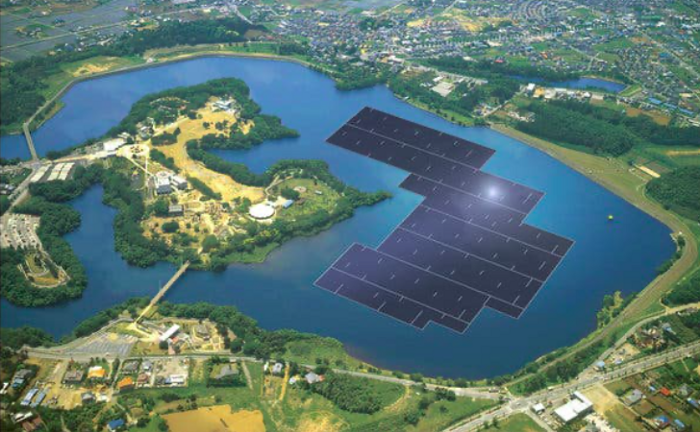Abstract
Circularity emphasizes recovery of materials; instead of the take-make-waste system of waste generation, circularity closes the loop and pulls resources (what was before called ‘waste’) out of the waste stream and into reuse, remanufacturing, refurbishment, or recycling to prolong the lifecycle of that material.
The way that the City of Austin has conceptualized circularity is by creating an online Materials Marketplace database, where companies can list and view ‘resource’ items available in the city and connect directly with buyers/sellers. The database is also used by the City to monitor its progress towards zero waste; used by innovators who devise schemes for reducing specific waste streams; used by entrepreneurs who devise new marketplace ideas for recovered resources; as well as academics who study materials flows. Material that was once going to landfill, is now recovered and circulating in the city, adding an additional $1.1 Billion USD to the local economy, 6,300 local jobs, and a refined, collaborative systems network of cooperation between businesses and corporations, the city, nonprofits, academics, and local citizens. As a result of the success of the marketplace, the model has expanded to other Metropolitans across the US, Canada, and even Turkey.
This Case Study is brought to you by Nelis’ 4REVS Research Program. Nelis is an NPO with an active and expanding network of young social innovators and leaders, sustainability practitioners, and creative minds from all continents (100+ countries) that enables us to provide experiential and on-the-ground knowledge. If you want to know more or be part of our network, please leave a comment! Or contact us in www.nelisglobal.org
Overall Description
The problem of traditional solar energy:
Drastic changes in global climate over the last few decades, connected with the burning of fossil fuels to meet rapidly growing energy demands, has prompted a massive search for renewable and sustainable energy sources. Over the last 10 years, the use of energy sources such as wind, hydroelectric, or bioenergy has increased ~8.5% annually. However, the need for low-cost renewable energy is motivating renewed interest in the viability of large-scale solar power.
Photovoltaic (PV) arrays harness the sun’s energy by converting incoming solar radiation into direct current (DC) electricity for transmission and consumption. Recent technological advances and decreasing capital costs are making solar systems more competitive in the energy market than ever before. The cost of PV has dropped dramatically in recent years with energy production prices falling between $20–40/MWh. These arrays are also appealing because they require minimal maintenance and are widely scalable to meet size and power specifications.
Traditional land-based PVs, however, suffer from known issues of low capacity and efficiency related to limited availability of sunlight (daily and seasonally), shading effects, and a small range of optimal ambient operation temperatures (25°C or less ). These factors lead to intermittent energy production and often result in the use of solar energy primarily to supplement energy generation during hours of peak demand when energy is most expensive to purchase and produce, rather than as a standalone system. Further, reduced PV panel efficiency requires larger swaths of land, nearly a 10,000 m area, to support a 1 MWh power station. The large requirement for dedicated space results in complicated land-use conflicts and environmental concerns.
Floating PV arrays: the future of solar energy:
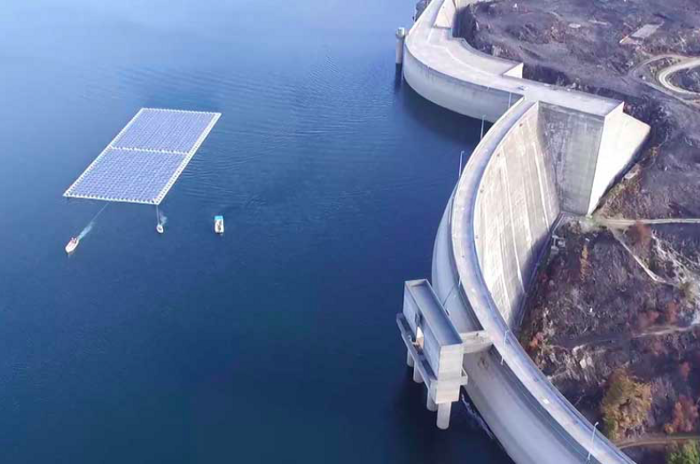
Growing pressure from the land-use competition, the need to fight climate change with efficient, green technologies, and the push for long-term energy resilience and security to meet rapidly increasing global demands is prompting industry leaders to explore the use of new, adaptable, and integrative solar energy systems.
Floating photovoltaics (FPVs) is an emerging and increasingly viable alternative to traditional, terrestrial-based solar arrays. These systems take advantage of the vast expanses of existing open water sources for utilization as a platform for solar arrays. Suitable waterbodies for use of FPV include lakes, reservoirs, and artificial basins built for water storage, runoff, irrigation, wastewater treatment, abandoned mines, etc. The diversity of open water sources enables businesses, municipalities, and government organizations to convert large, economically underutilized parcels of water-bearing land into revenue-generating, green energy producers. Estimates of FPV potential on only artificial water bodies across the continental US, for example, indicate a possible contribution of 2.1 TW of solar power generation assuming a maximum of 27% coverage of 21,961 km2 of suitable water surfaces. Even a largely arid state such as Colorado has the potential to generate 11 GW of solar energy using FPVs across a 416km water surface area.
FPV implementation has several advantages over traditional PV systems. Terrestrial arrays place heavy demands on dedicated, single-use land parcels, taking away space that might otherwise be used for agriculture, conservation, development, or civic needs. Migrating PV arrays to vacant surface water plots eliminate land-use competition while saving money on real estate, land preparation, and construction. FPVs are more compact, scalable, and have a simpler construction with less complex mechanical parts required for solar tracking, making them cheaper to install and easier to manage. The array’s mooring system is versatile, including bottom anchoring and shoreline mounting, and can be easily moved or rotated with little energy expenditure, an estimated savings of 15–25% of a traditional PV system.
Related to water, FPV systems have a somewhat symbiotic relationship. Because PVs most effectively operate in a narrow temperature range of less than 25°C, the natural cooling effect of the water on which the array sits, even on very hot days, allows the panels to operate close to optimum generation temperatures, maximizing energy output. Simultaneously, the panels reduce water absorption of solar radiance and reduce airflow across the surface keeping water temperatures cooler and reducing evaporation. Limiting evaporation is especially important in arid settings plagued by drought for at least part of the year as it preserves water resources for other uses such as irrigation. Note that these benefits scale with the size of the floating array. Large enough arrays may even help contain harmful algae blooms.
Hybrid FPVs: Coupled solar-hydro energy is a winning combination
A common theme across renewable energy sources is the inconsistent production and dispatch of power. For example, wind turbines require strong sustained airflow, solar requires 24-hour sun exposure, and hydropower requires year-round water resources, an impractical reality in each instance. However, if two or more of these technologies were strategically combined to offset power lows, renewable energy quickly becomes a consistent and reliable energy source.
Traditionally, hydroelectric dams run continuously, saving up water when demands are low and releasing it through turbines to generate power when demands are high, resulting in production spikes throughout the day. A hybrid design encourages FPV panels to run during the day when they are most effective, allowing for the conservation of more water resources for later power generation (hours or seasons) or other water use needs. The hydroelectric dam would then run primarily at night and during intermittent periods of exceptionally high demand or solar inefficiencies, making power supplies more regular.
In addition to the general advantages of FPV systems, the hybrid solar hydropower system also benefits from the use of existing infrastructure. Irregular generation of power by hydroelectric dams means that transmission lines often go underutilized, resulting in high infrastructure costs per megawatt-hour. Increased power generation through FPVs improves the production capacity factor and reduces costs. Further, excess generated solar power, rather than being wasted, can be used to pump water to higher elevation reservoirs. Water stored at higher elevation has more potential energy and behaves similarly to a natural battery waiting to be utilized as pumped storage hydropower.
What is the projected impact of hybrid solar-hydropower systems?
FPVs are a relatively new technology, however, their use has grown rapidly since the first installation. In 2007, FPVs accounted for only 1 MW of generated power. By 2018, that number grew to 1,314 MW and production is expected to reach 13,000 MW by 2022. Much of this recent market growth is driven by Asian countries where high land costs coupled with constraints on land availability and the prevalence of hydropower reservoirs make FPV viable and necessary. Given that hydroelectric dams exist on virtually every continent, the potential to produce gigawatts of additional energy from solar-hydro hybrids globally is not such a stretch.
A recent study conducted by researchers at the U.S. Department of Energy found that hybrid solar-hydropower systems could drastically cut solar development costs and meet nearly 40% of the world’s energy needs if utilized.
With considerations for reservoir size, distance from shoreline to optimize maintenance and operation costs and capacity of transmissive infrastructure where known, the researchers indicate that over 379,000 suitable hydroelectric dams exist globally for FPV installation. Estimates of installed capacity for far and nearshore scenarios spanning 8-20% surface coverage, respectively, suggest a generation potential of 3.0-7.7 TW representing 16-40% of the 2018 global energy consumption . While the study did not investigate economic feasibility for such installations, the results indicate that hybrid solar-hydropower systems could significantly contribute to global energy demands using this renewable energy.
Main features or Highlights
Several key advantages make floating solar arrays the renewable energy technology of the future:
- FPVs have a rapid growth potential over the next few decades. Installed FPVs grew from 1 MW in 2007 to 1,314 MW in 2018 and is expected to reach 13,000 MW by 2022.
- Estimates of untapped global potential range from 3.0–7.6 TW,~40% of global energy use. In the US, FPV potential contribution is estimated at ~2.1 TW.
- Versatile application of FPVs including lakes, artificial basins built for water storage, irrigation, or civil use. Also, wastewater treatment, hydroelectric dams, and abandoned mines.
- FPVs at hydroelectric dam sites can share power transmission infrastructure, reducing construction and capital costs.
- A hybrid, solar-hydroelectric construction increases consistency of power generation throughout the day and season, open water location minimizes the shading effect and maximizes solar exposure and temperature-regulating effect of water boots PV efficiency.
- Eliminates land-use conflicts by moving large arrays onto the water surface, reserving land for agricultural, ecological, or other purposes while minimizing land acquisition and site preparation costs.
- Promotes a healthy reservoir by reducing water temperature important for sustaining aquatic life, discouraging toxic algae blooms, and acting as a heat barrier to inhibit water evaporation.
- Reduction in greenhouse gas emissions by reducing the number of consumed fossil fuels.
Why is this Revolutionary?
Global increases in energy demand and the rapid, unbridled consumption of fossil-fuels to meet the needs of an exponentially growing society are stressing the Earth’s natural systems to their limits. Severe, long-lasting impacts on human health and the environment are motivating the search for clean, efficient, and sustainable energy technologies to build long-term energy resilience and security solutions. Further, the pressing need to tackle the climate crisis requires the immediate cessation of fossil-fuel consumption by energy consumers to dramatically limit the associated emission of greenhouse gasses into the atmosphere.
The coupling of two or more renewable energy technologies, such as solar and hydroelectric power, maybe a reasonable compromise to relieving pressure on the global power grid while reducing the overall carbon footprint. While separate, neither technology is a consistently reliable energy source, but together, the two technologies have the potential to create a harmonious, mutually beneficial, and dependable power source that offsets the weaknesses in each system. Moving solar arrays to float platforms uniquely tackle concerns over technological inefficiencies and opens large swaths of underutilized area for energy development.
Concrete examples
Because developing and rapidly growing countries across east and central Asia are actively investing in and developing clean, cost-effective energy strategies in near real-time, most concrete examples of this new hybrid technology are largely derived from those regions. Places such as the Andaman and Nicobar Islands in India and parts of Vietnam, Japan, Singapore, Sri Lanka, Cambodia, and Indonesia have already set tenders for new hybrid energy projects set for 2021–2022. However, similar strategies can easily be adapted in localities around the world, such as those in South Africa, Portugal, Albania, Germany, and the Netherlands.
Sirindhorn Dam, Thailand — The largest-of-its-kind hybrid dam:
In 2019, the Electricity Generating Authority of Thailand (EGAT) laid out plans for its first-ever floating solar array at the Sirindhorn Dam in Thailand’s Ubon Ratchathani Province. This is a collaborative project between EGAT and Energy China. The ~$28 million-dollar Hydro-Floating Solar Hybrid Project will establish a 45 MW capacity FPV behind the dam structure. The current hydroelectric generating capacity totals 36 MW.
The goal of the EGAT project is to establish a balance in energy generation at the dam site to better support the system’s year-round power demand. At present, hydroelectric power is only available at the dam part of the year as water scarcity during the dry season limits energy production. The idea is that the FPV would be used to generate power during the day when sunlight supports high solar efficiency. At night, hydropower would take over allowing for more continuous daily power generation and better management of water resources in the reservoir throughout the year.
Some highlights of the hybrid dam design include:
- Reduced infrastructure cost from the use of EGAT’s original dam power system for solar energy transmission
- The solar panels can track the sun’s orbit from morning to evening to generate power throughout the day
- Increased power security by utilizing solar power to stabilize the system and through the development of an energy management system to control power distribution
- Use of well-tested environmentally sensitive floating platform materials reduces risk to the environment and aquatic life
- Minimizes interference with existing land-use and recreational activities by installing the FPV on the water surface close to the dam structure which was already closed to the public.
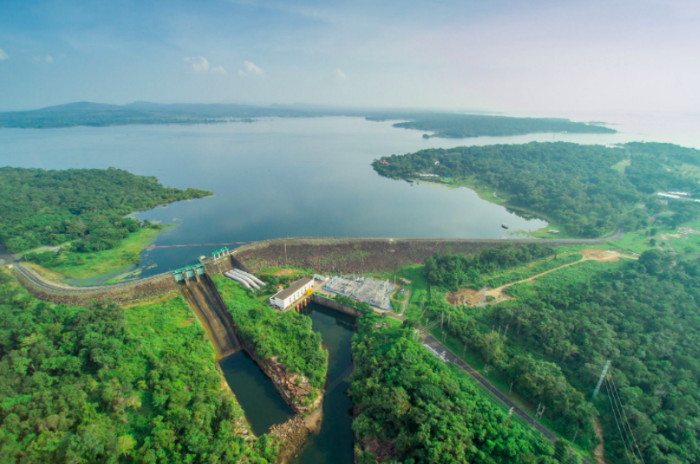
The dam is scheduled to begin commercial operation in December 2020. The project is set to be the largest hybrid solar-hydroelectric setup in the world. EGAT has plans in the works for 15 new hybrid dam projects across Thailand totaling 2.7 GW of potential energy output to be completed by 2037. This is equivalent to the output of ~4 mid-weight coal plants.
Recycled Water Storage Facility FPV, Windsor, California:
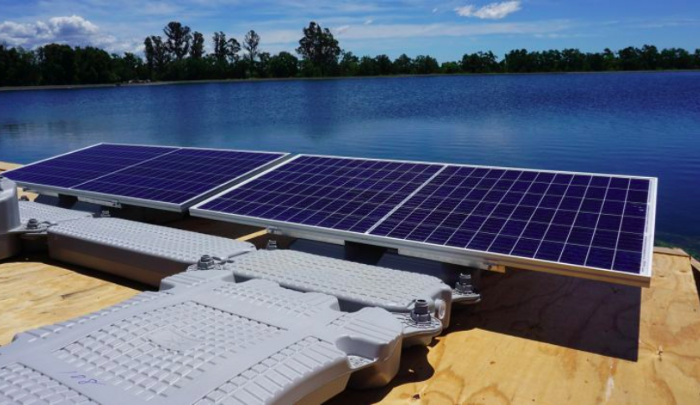
Construction has begun on a new 1.78 MW FPV installation at the recycled water storage facility in Windsor, California. The floating solar system, installed by Ciel et Terre USA, will be the largest-of-its-kind in the state and is set to provide nearly 90% of the treatment and pumping station’s electricity needs. This FPV is a standalone system tethered to the shoreline and will cover ~22% of the water surface with the possibility of future growth. The company is expecting additional California-based installations in the near future.
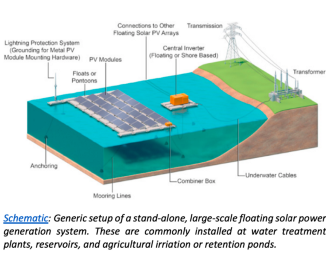
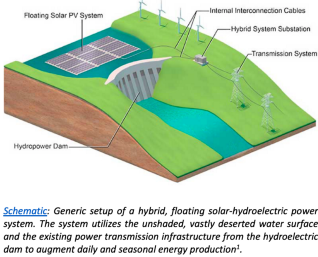
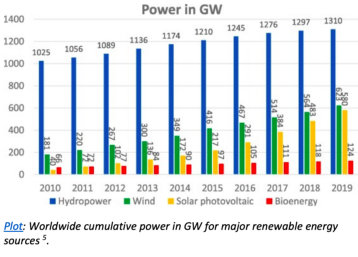
References:
- Patel, Prachi (2020). The immense potential of solar panels floating on dams. Anthropocene Magazine — Daily Science. Retrieved November 13, 2020. https://www.anthropocenemagazine.org/2020/10/the- immense-potential-of-solar-panels-floating-on-dams
- Lee, Nathan et al. (2020). Hybrid floating solar photovoltaics — hydropower systems: Benefits and global assessment of technical potential. Journal of Renewable Energy. https://doi.org/10.1016/j.renene.2020.08.0801415–1427
- Rahim, Saqib (2019). This floating solar farm is a dam clever climate change weapon. Wired. Retrieved November 13, 2020. https://www.wired.co.uk/article/sirindhorn-dam-thailand-solar- panels
- Griffiths, Jill (2018). Floating solar panels on farm dams set to cut energy costs. NSW Farmers. Retrieved November 13, 2020. https://www.nswfarmers.org.au/NSWFA/Posts/The_Farmer/Innovat ion/Floating_solar_panels_on_farm_dams_set_to_cut_energy_costs .aspx#:~:text=Savvy%20scientists%20have%20discovered%20a,effici ency%20by%20cooling%20them%20down.
- Cazzaniga, Raniero and Marco Rosa-Clot (2020). The booming of floating PV. The Journal of Solar Energy. (In Press, Correct Proof). https://doi.org/10.1016/j.solener.2020.09.057
- EGAT (2019). EGAT’s first floating solar project at Sirindhorn Dam combining hydropower and solar power is the largest hybrid power generation in the world. Electricity Generating Authority of Thailand. Retrieved November 18, 2020. https://www.egat.co.th/en/news- announcement/web-articles/egat-s-first-floating-solar-project-at- sirindhorn-dam-combining-hydropower-and-solar-power-is-the- largest-hybrid-power-generation-in-the-world
- Parnell, John (2019). Work starts on California’s largest floating solar project. PV-Tech. Retrieved November 18, 2020. pv- tech.org/news/work-starts-on-californias-largest-floating-solar- project

